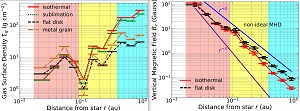- Details
- Published on 22 August 2019
Vol. 629
In section 1. Letters to the Editor
Close-in giant-planet formation via in-situ gas accretion and their natal disk properties
 The origin of Jupiter-like planets at close orbital distances from their star remains uncertain. Many models assume that their formation occurs beyond the snow line via core accretion, and that once formed, planets migrate inwards, either by planet-disk interaction or by planet-planet interaction coupled with stellar tides. Another class of models calls for in-situ formation instead. In this latter case, the distribution of exoplanets with distance must correlate with the formation efficiency, that is, by the ability of giant planetary cores to accrete local disk gas. Under this hypothesis, Hasegawa et al. use the observed occurrence rate of close-in Jupiters to infer the properties of the planet-forming disks, meaning the radial profile of disk temperature, surface density, and efficiency of angular momentum transport. Remarkably, the resulting density profile shows a general increase with distance, very different from the r^{-3/2} dependence in the standard Hayashi minimum-mass solar nebula (MMSN) model. Based on their disk model, the authors also infer the radial dependence of the magnetic field, and find that it switches from a regime of stellar dipole fields (r^-3) in the star vicinity to one of large-scale fields (r^-2) in the inner disk, with a transition near ~0.1 au that may correspond to the valley in the period distribution of giant exoplanets.
The origin of Jupiter-like planets at close orbital distances from their star remains uncertain. Many models assume that their formation occurs beyond the snow line via core accretion, and that once formed, planets migrate inwards, either by planet-disk interaction or by planet-planet interaction coupled with stellar tides. Another class of models calls for in-situ formation instead. In this latter case, the distribution of exoplanets with distance must correlate with the formation efficiency, that is, by the ability of giant planetary cores to accrete local disk gas. Under this hypothesis, Hasegawa et al. use the observed occurrence rate of close-in Jupiters to infer the properties of the planet-forming disks, meaning the radial profile of disk temperature, surface density, and efficiency of angular momentum transport. Remarkably, the resulting density profile shows a general increase with distance, very different from the r^{-3/2} dependence in the standard Hayashi minimum-mass solar nebula (MMSN) model. Based on their disk model, the authors also infer the radial dependence of the magnetic field, and find that it switches from a regime of stellar dipole fields (r^-3) in the star vicinity to one of large-scale fields (r^-2) in the inner disk, with a transition near ~0.1 au that may correspond to the valley in the period distribution of giant exoplanets.


